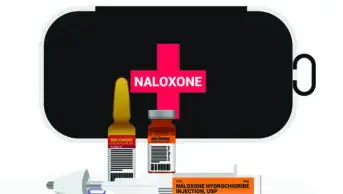Pregabalin, which is licensed to treat epilepsy, neuropathic pain and anxiety, hit the headlines in March 2024 after The Sunday Times reported that it has the fastest-rising death toll of any drug in the UK.
Along with gabapentin, pregabalin is a gabapentinoid — an analogue of the neurotransmitter γ-aminobutyric acid (GABA) that exerts its effect by inhibiting calcium-mediated neurotransmitter release — and a popular alternative to prescribing opioids. Research shows that the rate of patients newly treated with gabapentinoids tripled between 2007 and 2017 in primary care in the UK[1].
But a marked increase in the number of deaths linked to the drugs triggered their reclassification as a Class C controlled drug in April 2019, which introduced greater restrictions on prescribing.
Despite this, NHS data show an increase in prescribing since then, specifically for pregabalin. In 2022/2023, there were 10.3 million prescription items for pregabalin dispensed in the community across Great Britain, compared with 8.7 million prescription items in 2019/2020 (see Figure 1).
In contrast, prescription items for gabapentin — which is licensed for epilepsy and neuropathic pain but not anxiety — have levelled off, staying at around 8.8 million during the same period.
Julie Ashworth, senior lecturer and honorary consultant in pain medicine at Keele University, and author on a 2023 research paper on trends in gabapentinoid prescribing in UK primary care, says the research team noticed gabapentin prescribing started to decline before pregabalin prescribing, despite pregabalin receiving greater adverse publicity regarding its misuse potential[2].
We thought that the licence for anxiety may be contributing to prescribers choosing pregabalin over gabapentin
Julie Ashworth, senior lecturer and honorary consultant in pain medicine at Keele University
“We thought that the licence for anxiety may be contributing to this and also wondered if the greater availability of cheaper generic pregabalin had made it more likely that prescribers would choose this over gabapentin as their first choice, compared to previously, when the price differential was much greater,” she says.
Amira Guirguis, MPharm programme director at Swansea University and an expert in novel psychoactive substances, adds that the potency of pregabalin might explain prescribers’ preference for it over gabapentin. “Across various studies, pregabalin consistently demonstrates a greater potency than gabapentin[3]. This discrepancy in potency is likely attributed to differences in their respective pharmacokinetic profiles,” she says, with pregabalin being absorbed more rapidly and achieving a higher bioavailability.
According to prescription cost analyses, the largest increase in pregabalin prescribing since it was reclassified is in Scotland, where the number of prescription items dispensed increased by 24% between 2019/2020 and 2022/2023, followed by England at 19% and Wales at 13%.
Reclassification of pregabalin limited its prescription to 30 days’ treatment, which could have contributed to the rise in the number of prescription items. However, data from the NHS Business Services Authority (NHSBSA) show that the number of patients receiving prescriptions for pregabalin in England has also continued to increase, rising from 669,632 patients before the restrictions in 2018/2019 to 749,719 patients after the restrictions in 2021/2022 (see Figure 2).
What is driving the rise in prescribing?
There is concern that the increase in use of pregabalin is in response to decreasing trends in opioid prescribing[4].
Pregabalin is recommended by the National Institute for Health and Care Excellence (NICE) as one of the first-line options for neuropathic pain (except for trigeminal neuralgia) in adults, along with gabapentin, amitriptyline and duloxetine[5].
However, a recent study suggested there was widespread off-label prescribing of pregabalin for non-neuropathic pain — most commonly musculoskeletal conditions, such as low back pain — between 1997 and 2019 (see Figure 3)[2].
In 2020, NICE advised that pregabalin should not be prescribed for managing sciatica and, in 2021, ruled that it should not be prescribed for chronic primary pain[6,7].
For epilepsy and anxiety, pregabalin is not a first-line choice[8,9]. Guirguis says that some short-term trials have investigated the prescribing of pregabalin for patients with anxiety, either to augment benzodiazepine levels or as substitutes to benzodiazepines[10]. “Here, in South Wales, we have issued alerts and advice to prescribers on the harms related to benzodiazepines,” she says, questioning whether this could have led to an increase in pregabalin prescribing.
The people behind the prescriptions
In September 2019, Public Health England published a review on dependence and withdrawal associated with prescribed medicines, which included gabapentinoids, as well as benzodiazepines, Z-drugs, opioids and antidepressants.
The review recommended better monitoring, treatment and support for patients, including giving NHS commissioners and doctors better access to data to improve insight of prescribing behaviour. The NHSBSA now publishes annual data on dependency forming medicines, which show that most people prescribed gabapentinoids in England in 2022/2023 were females aged 55–59 years (see Figure 4).
Gabapentinoids are also more often prescribed for people living in areas of high deprivation. In 2022/2023, 445,000 people in the most deprived areas received gabapentinoids, compared with 231,000 people in the least deprived areas (see Figure 5).
“Most gabapentinoid prescribing seems to be for people with chronic pain, and chronic pain is more commonly reported by females and by people living in more deprived areas, so that probably contributes, although we found gabapentinoid prescribing increased with age, which would be more expected,” says Ashworth.
These patterns of prescribing are common in other dependency-forming medicines.
Drug misuse deaths rise
Pregabalin was reclassified after a public consultation and advice from the Advisory Council on the Misuse of Drugs, which was concerned about the risks of “illegal diversion and medicinal misuse”. It followed a marked increase in the number of deaths linked to gabapentinoids, which can cause euphoria, sedation and dissociation, making them sought after as a recreational drug.
Guirguis explains that pregabalin, in particular, exhibits a potent effect on calcium channels, reducing the release of excitatory molecules, such as glutamate, noradrenaline, and substance P (but not dopamine), thereby counteracting the neuronal stimulation caused by certain addictive substances, which typically elevate extracellular dopaminergic activity in the mesolimbic reward system.
This explains why some patients may suffer from respiratory depression and potential deaths if they have lost tolerance to opioids
Amira Guirguis, MPharm programme director at Swansea University and an expert in novel psychoactive substances
However, gabapentinoids also cause depression of the central nervous system, resulting in drowsiness, sedation and respiratory depression. Research suggests that gabapentinoids alone rarely cause death, but clinically-relevant doses can be fatal, possibly owing to their reducing of tolerance to opioids[11]. “This explains why some patients may suffer from respiratory depression and potential deaths if they have lost tolerance to opioids,” says Guirguis.
In England and Wales, the latest data for drug-related poisonings where pregabalin was mentioned on the death certificate show an increase from 187 deaths in 2018 to 441 deaths in 2022. Over the same period, the number of drug-related poisonings where gabapentin was mentioned on the death certificate has increased from 93 deaths to 135 deaths.
In Scotland, gabapentin and/or pregabalin was implicated in 367 drug misuse deaths in 2022, down from a peak of 502 deaths in 2020 (see Figure 6).
Pregabalin misusers achieve euphoric effects by taking large quantities, ranging from 200mg to 5g as a single dose (maximum licensed dose is 600mg daily in two or three divided doses); its pharmacokinetics make it relatively more dangerous than gabapentin in high doses[12].
Pregabalin is present as part of polydrug use. We see it with opiates, benzodiazepines and cocaine
Catriona Matheson, professor in substance use at the University of Stirling
Catriona Matheson, professor in substance use at the University of Stirling and former chair of the Scottish government’s Drug Deaths Taskforce, tells The Pharmaceutical Journal that gabapentin has historically been the gabapentinoid most often implicated in drug-related deaths in Scotland, but adds that she has seen a recent increase in pregabalin in reviews of drug-related deaths conducted with colleagues in Aberdeen.
“[Pregabalin] is present as part of polydrug use. We see it with opiates, benzodiazepines and cocaine,” says Matheson, adding that it is likely to have come from a diverted prescription source.
Co-prescription with opioids rising
The central nervous system-depressant effects of gabapentinoids are additive when used with other centrally-acting drugs, particularly opioids, and caution is advised when they are prescribed together. Research based on data from the National Programme on Substance Abuse Deaths suggests that in a quarter of gabapentinoid deaths in England (772/3,051 deaths) between 2004 and 2020, gabapentinoid had been co-prescribed with an opioid and in 92% of deaths following gabapentinoid use, opioids were co-detected[12].
Despite these risks, co-prescribing of gabapentinoids with opioids and other dependency-forming drugs appears to be increasing.
NHSBSA data show that in April 2015 there were 101,126 patients receiving prescriptions for both opioids and gabapentinoids, whereas, in March 2023, there were 149,853 patients co-prescribed these medicines (see Figure 7) — an increase of 48%. Meanwhile, the annual number of patients being prescribed gabapentinoids alone increased by 25% between 2015/2016 and 2022/2023 and the number being prescribed opioids alone decreased by 14%.
“I think it reflects that most gabapentinoid prescribing is for chronic pain and the lack of effectiveness of most medicines for most patients with chronic pain tends to lead to polypharmacy, despite the lack of evidence supporting this, because the availability of and access to alternative non-pharmacological pain management is patchy,” says Ashworth.
Her study on trends in gabapentinoid prescribing between 1997 and 2019 found that gabapentinoids were commonly co-prescribed with opioids (60%), antidepressants (52%), benzodiazepines (19%), and Z-drugs (10%)[2].
What can pharmacists do?
The increasing number of drug-related deaths may in part be addressed by ensuring that pregabalin is being prescribed appropriately.
Catriona Matheson, professor in substance use at the University of Stirling and former chair of the Scottish government’s Drug Deaths Taskforce, tells The Pharmaceutical Journal that it would be helpful to investigate whether gabapentinoid use across Scotland could be audited.
“Now that we have more pharmacists working within general practices, should they be reviewing patients taking pregabalin and gabapentin to ensure it is being prescribed appropriately?” she asks.
Julie Ashworth, senior lecturer and honorary consultant in pain medicine at Keele University and author on a 2023 research paper on trends in gabapentinoid prescribing in UK primary care, believes so, stressing that practice pharmacists involved in structured medication reviews (SMRs) could help by reviewing the effectiveness of gabapentinoid therapy and supporting gradual tapering and stopping, where risks outweigh benefits[2]. “As well as reducing the risk to individual patients, this will reduce the supply available for diversion in the community, which is a major factor in gabapentinoid-related deaths.”
SMRs were introduced in primary care in England in 2020 for a range of patients, including those using potentially addictive pain management medication.
“Pharmacists should carefully monitor and review the prescribing of gabapentinoids for patients with a history of substance use; those who make specific requests for initiation, especially post release from prison; individuals who repeatedly request early prescriptions or emergency supplies,” adds Amira Guirguis, MPharm programme director at Swansea University and an expert in novel psychoactive substances. “Regular reviews and monitoring for signs of misuse, diversion, and dependence are imperative for all patients,” she says.
Ashworth suggests that community pharmacists could prompt people to get their medicines reviewed; highlight potential dangers of drug combinations, such as opioids and gabapentinoids; and alert prescribers to any concerns they have.
- 1Montastruc F, Loo SY, Renoux C. Trends in First Gabapentin and Pregabalin Prescriptions in Primary Care in the United Kingdom, 1993-2017. JAMA. 2018;320:2149. https://doi.org/10.1001/jama.2018.12358
- 2Ashworth J, Bajpai R, Muller S, et al. Trends in gabapentinoid prescribing in UK primary care using the Clinical Practice Research Datalink: an observational study. The Lancet Regional Health – Europe. 2023;27:100579. https://doi.org/10.1016/j.lanepe.2022.100579
- 3Schifano F. Misuse and Abuse of Pregabalin and Gabapentin: Cause for Concern? CNS Drugs. 2014;28:491–6. https://doi.org/10.1007/s40263-014-0164-4
- 4Optimising personalised care for adults prescribed medicines associated with dependence or withdrawal symptoms: Framework for action for integrated care boards (ICBs) and primary care. NHS England. 2023. https://www.england.nhs.uk/long-read/optimising-personalised-care-for-adults-prescribed-medicines-associated-with-dependence-or-withdrawal-symptoms/ (accessed 21 May 2024)
- 5Neuropathic pain in adults: pharmacological management in non-specialist settings. National Institute for Health and Care Excellence. 2020. https://www.nice.org.uk/guidance/cg173 (accessed 21 May 2024)
- 6Low back pain and sciatica in over 16s: assessment and management. National Institute for Health and Care Excellence. 2020. https://www.nice.org.uk/guidance/ng59 (accessed 21 May 2024)
- 7Chronic pain (primary and secondary) in over 16s: assessment of all chronic pain and management of chronic primary pain. National Institute for Health and Care Excellence. 2021. https://www.nice.org.uk/guidance/ng193 (accessed 21 May 2024)
- 8Epilepsies in children, young people and adults. National Institute for Health and Care Excellence. 2022. https://www.nice.org.uk/guidance/ng217 (accessed 21 May 2024)
- 9Generalised anxiety disorder and panic disorder in adults: management. National Institute for Health and Care Excellence. 2020. https://www.nice.org.uk/guidance/cg113 (accessed 21 May 2024)
- 10Schifano F, Chiappini S. Pregabalin: A range of misuse‐related unanswered questions. CNS Neurosci Ther. 2019;25:659–60. https://doi.org/10.1111/cns.13115
- 11Kalk NJ, Chiu C, Sadoughi R, et al. Fatalities associated with gabapentinoids in England (2004–2020). Brit J Clinical Pharma. 2022;88:3911–7. https://doi.org/10.1111/bcp.15352
- 12Advice for prescribers on the risk of the misuse of pregabalin and gabapentin. Public Health England. 2014. https://assets.publishing.service.gov.uk/government/uploads/system/uploads/attachment_data/file/385791/PHE-NHS_England_pregabalin_and_gabapentin_advice_Dec_2014.pdf (accessed 21 May 2024)



